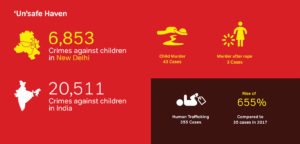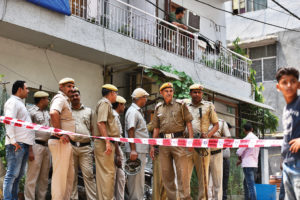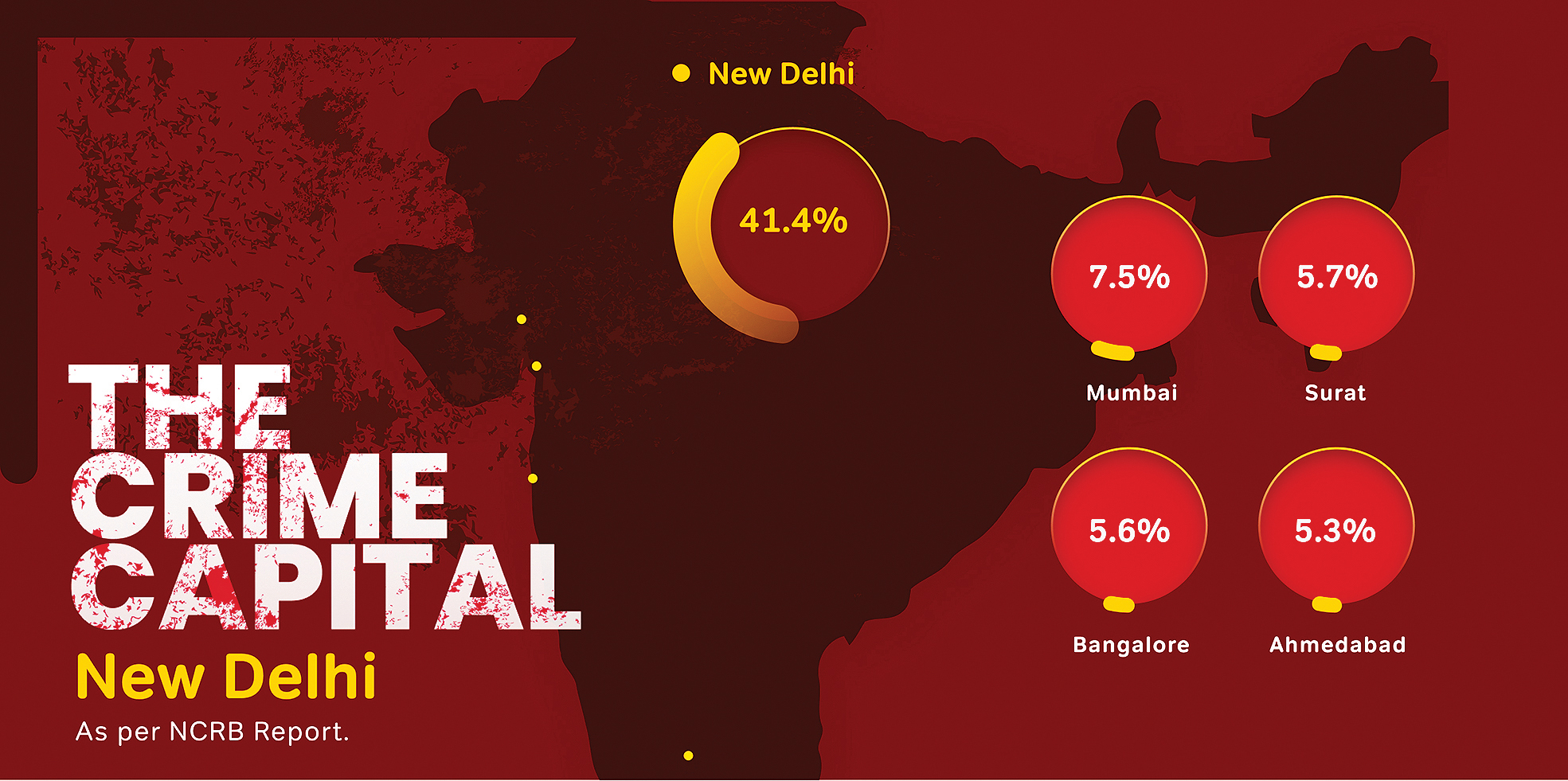Delhi has the highest incidence of heinous crimes like rape and murder as well as theft and snatchings among indian cities. The reason is a peculiar combination of circumstances
ON SEPTEMBER 1, Sanjeev Khosla registered a complaint at Chittaranjan Park police station about a theft in his parents’ house in the area. Reaching there, police found that Khosla’s father, 91-year-old Krishna Khosla, was missing along with his domestic help Kishan. Sanjeev’s mother Saroj alleged that she had fallen unconscious after taking tea mixed with sedatives served by Kishan on August 31.
Two days later, police arrested five suspects including the domestic help. Other four accused are Deepak Yadav, Pradeep Sharma, Sarvesh and Prabhudayal.
When interrogated, Kishan told police that he abducted and killed the old man by strangling him. He also said he kept the body in a refrigerator for four days, chopped the body into pieces and dumped the body in a barren plot of land in Tigri.
This is just one of the 619 crimes that the Capital sees on a daily basis. Not surprisingly, Delhi tops all the crime charts of the country with 41% share of the total crimes committed, as per the recently released Crime in India Data by NCRB.
In fact, two out of five crimes committed in the country occur right here in Delhi. If we look at data for metro cities only, then Delhi is miles ‘ahead’ of any other big city. The runner-up is Mumbai, which accounted for 40,757 cases, which is five times less than that of the capital. The other metro cities – Bengaluru (30,792 cases), Chennai (20,160 cases) and Kolkata (19,682) – are way down the pecking order.
It’s not a recent phenomenon. For the past three years, Delhi has recorded the most crimes in the country. Which brings us to the question: Why does Delhi continue to rule the charts?

Anil Mittal, additional PRO, Delhi Police explains that since there is a facility for online registration of FIRs, the number of complaints goes up to a very high number. Former Commissioner of the Delhi Police Neeraj Kumar is of the same opinion, saying that the data shows a high number of crimes because more complaints are registered here than in any other city in India.
Kumar also states that the mentality of the people of Delhi is one of the major reasons why the crime is so high here. “Delhi’s hinterland area — particularly Punjab, Haryana and UP have a much more rough mentality”, he says. If you see, here most people talk in a crude manner and even their attitude is not mild-mannered at all”.
He goes on to say that more than 60-70 per cent population consists of people who migrated from these states. “Most of the criminals that I have encountered during our time mostly have this same mentality of ‘Jo kiya acha kiya’ and show no remorse at all”, he adds.
According to the Census 2011, almost two lakh people migrate from other parts of the country every year to settle in Delhi. This huge infux of people on a regular basis, leads to more crime in the city, as per the former DCP.

He also points out that the sheer mass of Delhi’s population too is a contributory factor. Delhi is the most populated city in the country, according to a 2018 United Nations report, which states that 1.9 crore people reside here in the capital, making it one of the most populous cities in the world. “No less than 12,803 people reside per square kilometer in Delhi, thus making it the most densely populated city in India. “The more the density of population, the more the chances of crimes being committed”, says Kumar.
In contrast, the number of police personnel currently deployed in Delhi, as per the Ministry of Home Affairs data, is 83,762, out of which 25%, i.e 20,940 policemen, are deployed for the protection of VIPs. So, 62,821 policemen protect the rest of Delhi’s population. Which means for every 300 people in Delhi, there is one policeman, which according to Kumar is a very low people-to-police ratio. This, according to him, makes it easier for criminals to commit crimes
Delhi shares a border with both Haryana and Uttar Pradesh, and hence it is easier for criminals to commit a crime and escape to these states, out of the jurisdiction of Delhi Police. According to Kumar, most crimes occur in parts of East Delhi notably Mayur Vihar, Nirman Vihar and Laxmi Nagar from where criminals can easily flee to Noida or Ghaziabad, which fall under UP police.
WOMEN IN DANGER
Malti (name changed) was quite a popular girl in a middle class locality in South Delhi. A nurse by profession, she has always been the apple of her parents’ eyes, and the pride of the family since she was the first to be associated with the medical profession.
A first glimpse of her and she would seem like a pretty confident girl in her early twenties, who loves her job. “I topped my nursing course”, she says proudly. But a horrific incident exactly a year ago shook her to the core.
She was returning late from the hospital after attending to an emergency case. It was late in the night, and she was just one kilometre from her home, when suddenly a red car stopped in front of her. In no time, she felt someone dragging her by the arm, and something shoved in her mouth.
The next thing she knew that she was in a moving vehicle with two men. She could not cry for help as she was gagged. Malti was raped multiple times by two men that night in June 2018. This is a typical case of rape in a moving vehicle, of which the worst one which shocked the nation was Nirbhaya’s.
After the incident, Malti had to endure the whole culture of victim shaming. Instead of blaming the ones who commit such a heinous crime, the fact that their actions escape scrutiny is also one of the major factors why crime against women is so high in the capital.
“After the incident with me, the same people in my family who congratulated me on becoming a nurse avoided me and my parents. They gave us cold shoulders, and I was not even invited to my cousin’s wedding last year because they didn’t want people to talk about me”, says Malti.
She also says that many of her friends stopped talking to her, and she even heard some elders in her neighbourhood saying that this happened because she was out late at night. “Most people didn’t even condemn the men who actually raped me”, she says, with regret.
CULTURE OF IMPUNITY
A few years ago, in a public speech, Prime Minister Narendra Modi had called Delhi the “rape capital” of India, owing to the large number of crimes against women that happen in the capital. The NCRB data shows no difference, as there have been 11,724 crimes against women — which means that there has been one crime committed against women every hour.
There have been 1,080 cases of rape in the capital – a rape every 12 hours. What is startling is that the number of cases is the same when we compare it with the last released data. In this instance too, the capital tops the charts. In fact, almost one out of 10 rapes in India happen right here in Delhi. The closest city to Delhi is the Mumbai with 319 rapes — one-third of the rapes here.
“Yes, women’s safety is seriously a major issue in Delhi”, says Neeraj Kumar who oversaw the Nirbhaya case when he was police commissioner. “I can say that Delhi was not safe for women then and it still continues to be so.”
He again blames it on mindsets. “The mentality of North Indian men towards women is very condescending. They tend to look upon women as an object, and not consider them proper human beings. The attitude towards looking down upon women results in a lot of crime against them,” infers Kumar
According to criminal psychologist Anuja Kapur, the thought of getting away with something as heinous as rape is very much prevalent among men, which is why there are so many crimes against women. “We all saw what happened with the Nirbhaya case. Even after a date was announced it got delayed”, says Kumar, referring to the fact that the date of hanging of the prisoners was postponed from January 22, after one of the convicts filed a mercy petition.

“Here, justice gets delayed, and in some cases denied, and hence men have the audacity to commit such crimes”, she says. In a mercy petition of one of the four convicts of the Nirbhaya case, Akshay Thakur, he mentions how they should not receive capital punishment because they will anyway die due to the air pollution in Delhi. Such a naive comment can only be made by someone who does not regret his actions”, says Kapur
However, there is much more violence against women that does not get much attention.
“We shouldn’t have let our daughter get married to that monster”, says 28-year-old Shiela’s father outside the burns ward of AIIMS. Sheila was recently burned by her husband and in-laws allegedly after they did not receive dowry after torturing her repeatedly.
“He seemed a nice guy, but we never thought that he and his family would turn out like this and hurt my poor child”, says her mother with tears in her eyes
Cases of domestic violence too reveal quite startling numbers. With 3,131 cases, Delhi tops this too, with Hyderabad coming in second position with 1,343 cases — the difference between them being a whopping 1,788.
In fact, there have been 14 acid attacks in the capital, out of a total of 40 that happened in the whole of the country.
Kumar points out that the low sex ratio of the capital can also be one of the reasons why there are so many crimes against women. In fact, among 35 states and Union Territories, the sex ratio of Delhi at 868 women per 1,000 men, is the fourth worst in India, and much lower than the country’s average of 940.
“The low sex ratio means that there are more men compared to women, and it is easier for them to trample the weaker sex, and hence the large number of crimes against women”, he opines.
Looking ahead: Is Delhi getting safer for women? Well, the statistics show that it is a resounding no, and the underlying factors that cause the high prevalence of crime

CRIMES AGAINST CHILDREN
What is telling from the NCRB data is that Delhi is not only unsafe for women, but it is also a breeding ground for crimes against children.
There have been 6,853 cases of crimes against children, which is one-third of the total number of such crimes in the country. Of these, 1520 cases are those that fall under the POCSO act, which deals with sexual assault and molestation of minors. This number like all previous data are the highest in the country.
Roshni (name changed) was born in a very poor family to a mason father and a mother who worked as a domestic help. On December 2018, tragedy struck the family when she went missing suddenly. She was only three years old at the time.
The police and the family then launched an investigation to find the missing girl, when finally her unconscious body was found lying near the family’s home in Sanyog Vihar.
She was rushed to a nearby hospital, where doctors declared her dead on arrival. It was also found out that the child was brutally raped, and had succumbed to her injuries.
On further investigation it was found out that the culprit was a security guard who resided near the child’s house and was familiar to the family. The man is 40 years old.
“Children are easy prey for predators, and we have found out by our research that places like Delhi and UP are filled with most people with such paedophilic tendencies”, says Anuja Kapur, citing this as the primary reason for such a heinous crime.
Other than that, another telling statistic is that there are 355 cases of child trafficking this time as compared to 47 in the last report. This means there has been an increase by 6.5 times.
So, why this sudden jump in the number of child trafficking cases? A police official from Delhi Police’s Anti Human Trafficking cell says that this has been possible because the police have been able to identify and crackdown more such child trafficking and prostitution rackets than ever before.
“We have increased our network, and come up with more efficient and better ways to track down such cases. Also, a lot of NGOs dedicated to child trafficking have provided us, volunteers, for our crackdown missions”, he adds. He claims in the past one or two years, his team has been working day in day out and the rise in the number of cases is due to the fact that more children have been reported and tracked down.
THEFT
The most common crime in the capital, according to the NCRB report is the number of thefts in the city. In fact, the numbers account for 80% of the total number of crimes that occur in the city. In fact one-third of the total number of thefts in India happen in the Capital itself.
This is visible in the vast number of thefts and snatchings that have occurred in the city in the past few years, becoming quite a big nuisance for all citizens.
The share of theft among all crimes in Delhi has been showing an upward trend — from 43% in 2009 to 80% in 2018. So, why this large number of thefts in Delhi?
Theft has always been a common crime in Delhi, according to Neeraj Kumar. “It happens because of lack of education, and such people not getting jobs”, he says. According to the NSO report, the rate of unemployment in Delhi rose from 3.1% in 2015-16 to 9.4% in 2017-18, thus plummeting to an all-time low.
“As we all know, there is a larger number of unemployed people in the country now than ever before, and hence more such crimes occur”, says Kumar. Most thieves and snatchers are mostly youngsters, who are either unemployed or are poorly educated and have no other way to earn money than by stealing or snatching, opines Kumar
Anil Mittal says that the rise in the number of theft cases is because of the fact that people report such cases more, especially since Delhi Police is the first police department in India that enables victims to lodge e-complaints for any kind of theft.
“Due to easy access, people register more complaints and hence the number of theft cases has gone up”, adds Mittal.
With inputs from Mayank Jain and Proma Chakraborty





